
Wearing a parachute-laden ‘rhino suit,’ a gunner from RAF 264 Squadron prepares to climb inside the turret of his Boulton Paul Defiant.
Those of you who follow our Facebook page have probably seen us talk about Fred Bieser. Fred is a turret restoration specialist from Lithonia, Georgia and we reached out to him to help us prepare for the long-term goal of acquiring and restoring Lucky Thirteen‘s turrets. Turrets are incredibly rare and expensive and, to be honest, we are not wealthy enough to just buy one on a whim. This is a project that is going to take time.
Fred is a genuinely talented and friendly guy and he too came from humble beginnings. His interest in the war started with his uncle, PO2 Arthur Russell, who was lost aboard the Gato class sub USS Snook (SS-279) in the South China Sea in 1945. Fred began by scrounging for turrets in the junkyards of Macon, Georgia and, as time went by, turrets all over the world started finding him. Throughout several buildings at his home, Fred’s collection of discarded turrets includes such pieces as: an Armstrong Whitworth Whitley tail turret, an Avro Lancaster nose and top turret, a B-25 Mitchell top turret, a B-29 Superfortress radar-assisted tail turret, a B-32 Dominator tail turret, a B-36 Peacemaker retractable turret, a Boulton Paul Defiant fighter turret, a PBM Mariner tail turret, a P2V Neptune tail turret, and several B-17 chin turrets and B-24 top turrets. And that’s just reciting from memory…
In fact, I must apologize: I was so enthralled in seeing everything that I failed to take as many pictures as I should have. One day I’ll visit again and try to take more photos.
Turrets have fascinated me for as long as I can remember; it was one of the things about Second World War aviation that attracted me the most. When Fred visited us a couple months back, he invited me down to his shop to return the favor. It has been an unusually hot and humid summer and it even rained during our visit. Still, it was an experience I will never forget and I thank Fred for the opportunity.
For our visit he hauled out two of the operational turrets he keeps on his property (most of his operational units are now in museums). My wife and I got the once-in-a-lifetime chance to not only witness, but control an operational B-24 nose turret and B-17 chin turret. Here are some details regarding these two pieces:

Fully restored example of an Emerson Electric A-15 Nose Turret. Made in Ferguson, Missouri, this turret was designed in mid-1943 following calls for improved forward facing armament on Consolidated B-24s. This particular turret served over England in 1945, having been sent stateside for repairs after the surrender (Fred still has her maintenance tag reading “August 1945”).
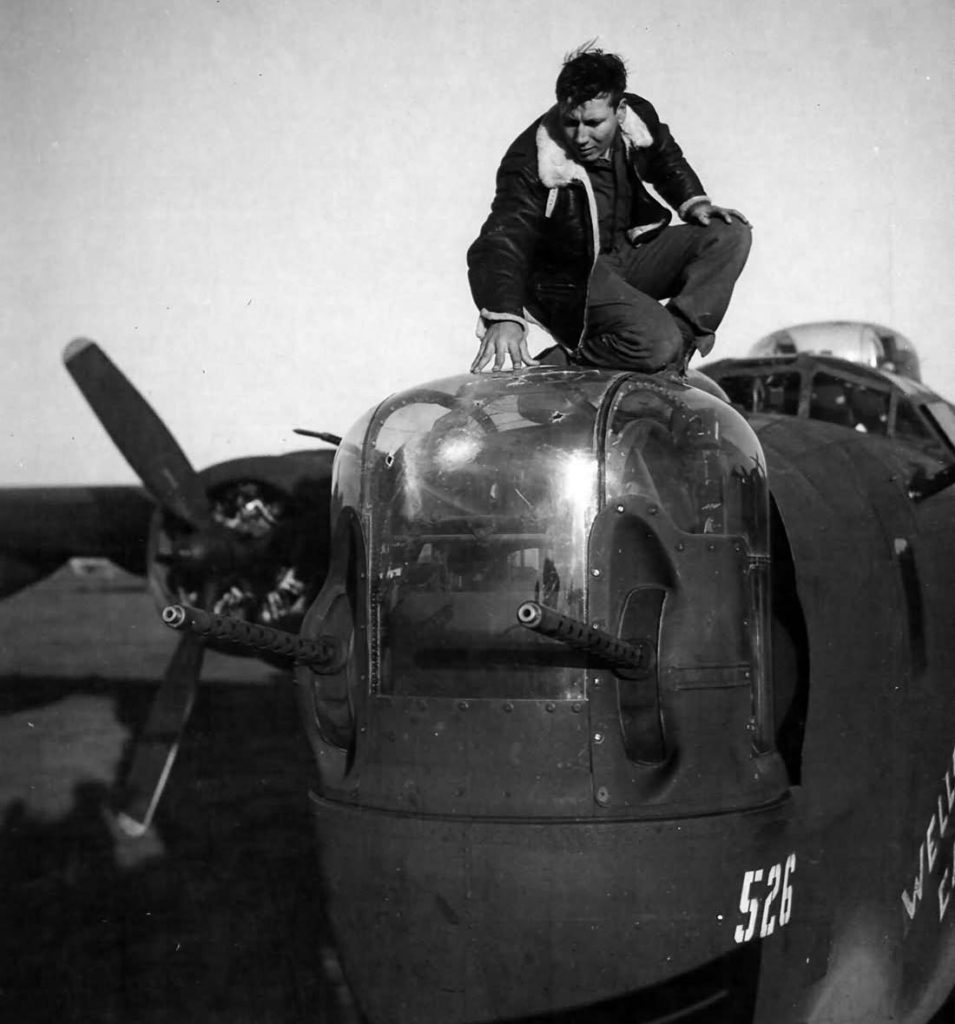
Navigator 2LT Joseph P. Orley examines a close-call on the Emerson A-15 Nose Turret aboard B-24H Wells Cargo (42-52142, 450BG). A penetration – either from a flak burst or a .32 caliber bullet, based on its size – has been stopped by the bulletproof glass inside. While Orley survived the war, his aircraft did not, being lost over Austria on 24 May 1944.

Early Boeing B-17s and Consolidated B-24s lacked forward facing armament due to the belief that modern airspeeds were too fast for head-on attacks. This was wrong. American airmen proved ingenious in their attempts to solve this problem and some of their solutions became quite popular. One was CO 90BG COL Arthur H. Rogers, who took the opportunity to experiment on a B-24D which had been damaged in a 1942 accident. This airplane, Susabella (41-23765), was sent to a depot in Brisbane, Australia where she was given a new nose designed to hold a giant Consolidated A-6 Tail Turret. The modified aircraft, renamed Connell’s Special after the depot commander, flew its first mission with a nose turret on 10 April 1943 over Wewak, New Guinea. All consequent Pacific-bound B-24s were altered in said manner until Emerson introduced the A-15 in June, which was designed specifically to be mounted in the nose.
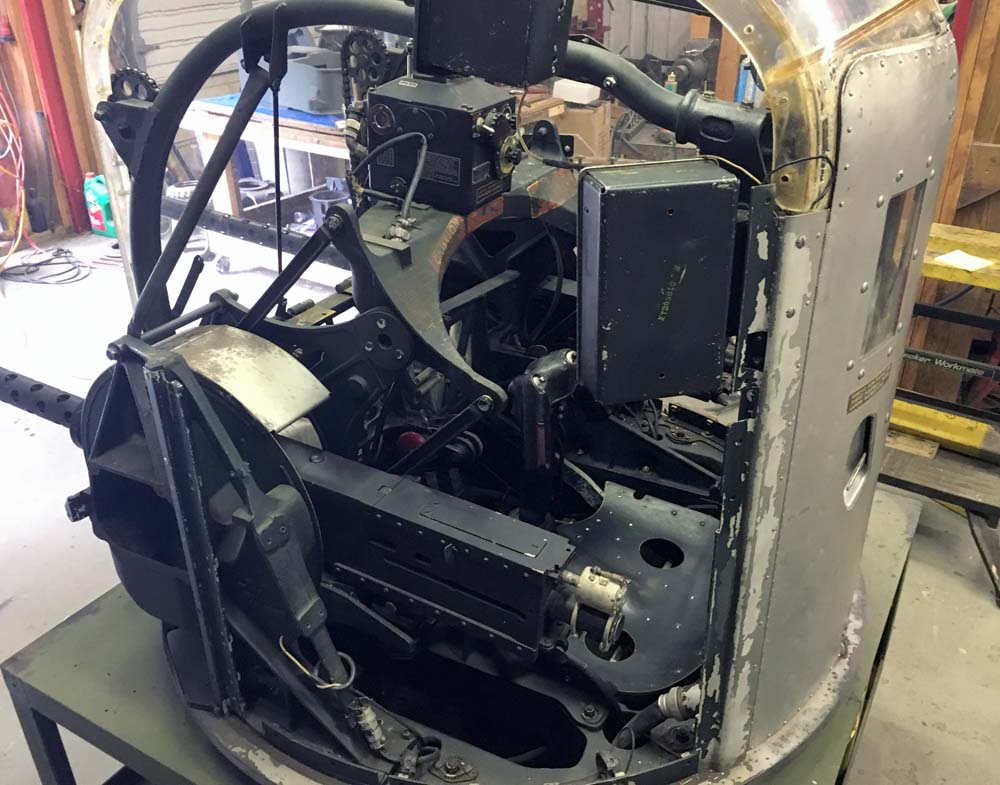
The left side of Fred’s Emerson A-15 Nose Turret is kept open to keep an eye on visitors inside. Here you can see the turret’s inner workings: the gunner sits between two Browning AN-M2 .50 caliber machine guns, with the sight and seat swiveling up and down with the guns. The units which power the turret are kept under a nearby cart, the roof of which is used to aid visitors in sliding through the turret’s door.

The K-11 Gunsight inside Fred’s Emerson A-15 Nose Turret. Made by Sperry Gyroscope of Brooklyn, New York, the K-11 was one of several compensating sights made during the war. The gunner input the aircraft’s altitude and airspeed, and the gears inside adjusted the reticule (reflected on the glass piece above) to compensate for the effects. Note the warning labels on the sight’s stand assembly: untouched since the Second World War.

Looking underneath the gunsight at the control column of the Emerson A-15 Nose Turret. The two red, rectangular buttons are the turret’s safety switches and must be depressed to move the turret. The left thumb knob is the push-to-talk button for the intercom and the right thumb knob increases the turret speed for emergency situations. The triggers for the guns are on the opposite side. All of Fred’s guns are replicas.
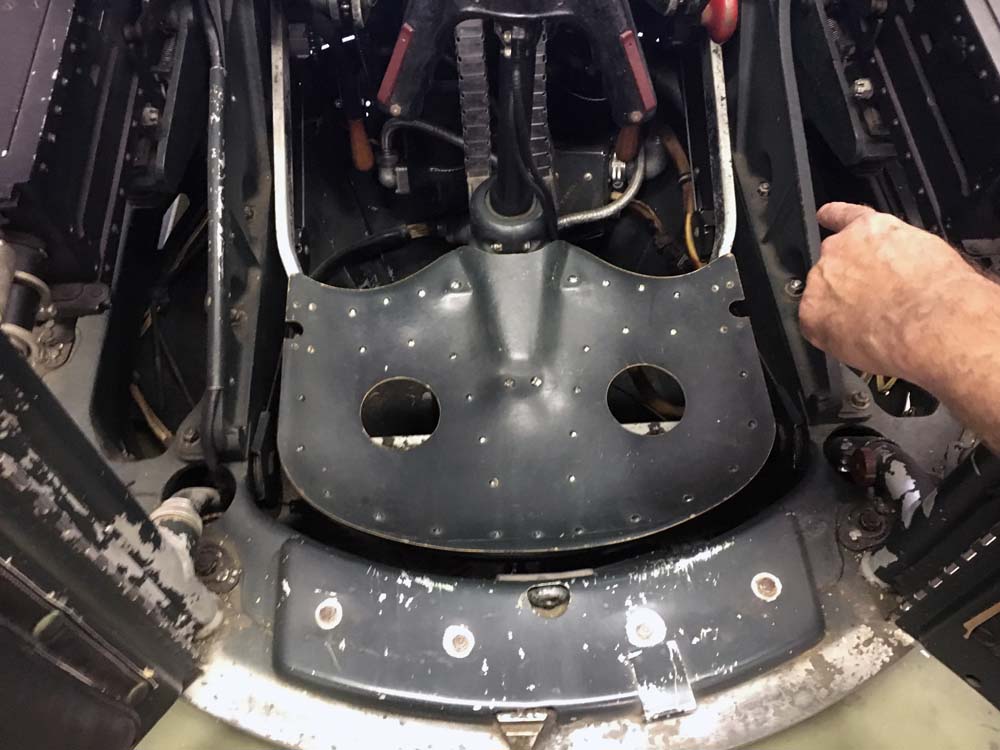
The phenolic seat plate for the gunner inside the Emerson A-15 Nose Turret. The seat moves up and down with the guns, keeping the gunner in position to view the sight. Reflecting sights like the K-11 were made so that, in order to see the reflection, the gunner had to keep his head in the proper position – hence the moving seat. While the leg area is fairly roomy, the paint on the seat supports has rubbed off from its gunners wearing heavy flight gear.

The inside of one side of the Emerson A-15 Nose Turret’s entry door. A back pad is provided for the gunner to lean up against. The paint inside the turret – untouched since the war – is the Dark Dull Green color I described in my article on Interior Paint Colors.
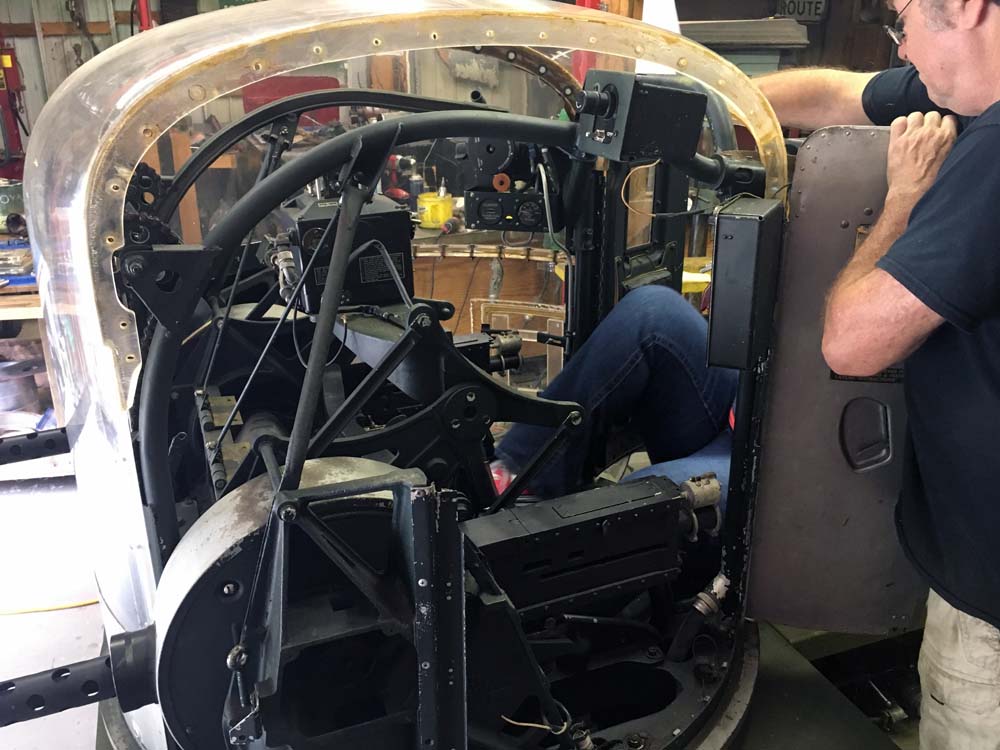
Fred helps my wife Megan into his restored Emerson A-15 Nose Turret. The scorching from the guns having been fired in wartime is evident on the gun swivel closest to the camera. Unfortunately, we do not know the identify of the particular B-24 this turret came off of. To the right of the gunner’s head (above Megan’s leg) is the turret’s oxygen regulator and indicator.

Seemingly gone are the days where one could find such pieces laying around in junkyards. Here, a tree has grown throughout hunks of another Emerson A-15 Nose Turret Fred had found. The piece with the knobs is the main control box, which is normally attached to the left of the gunner’s head. An incredible display on how time takes its toll.
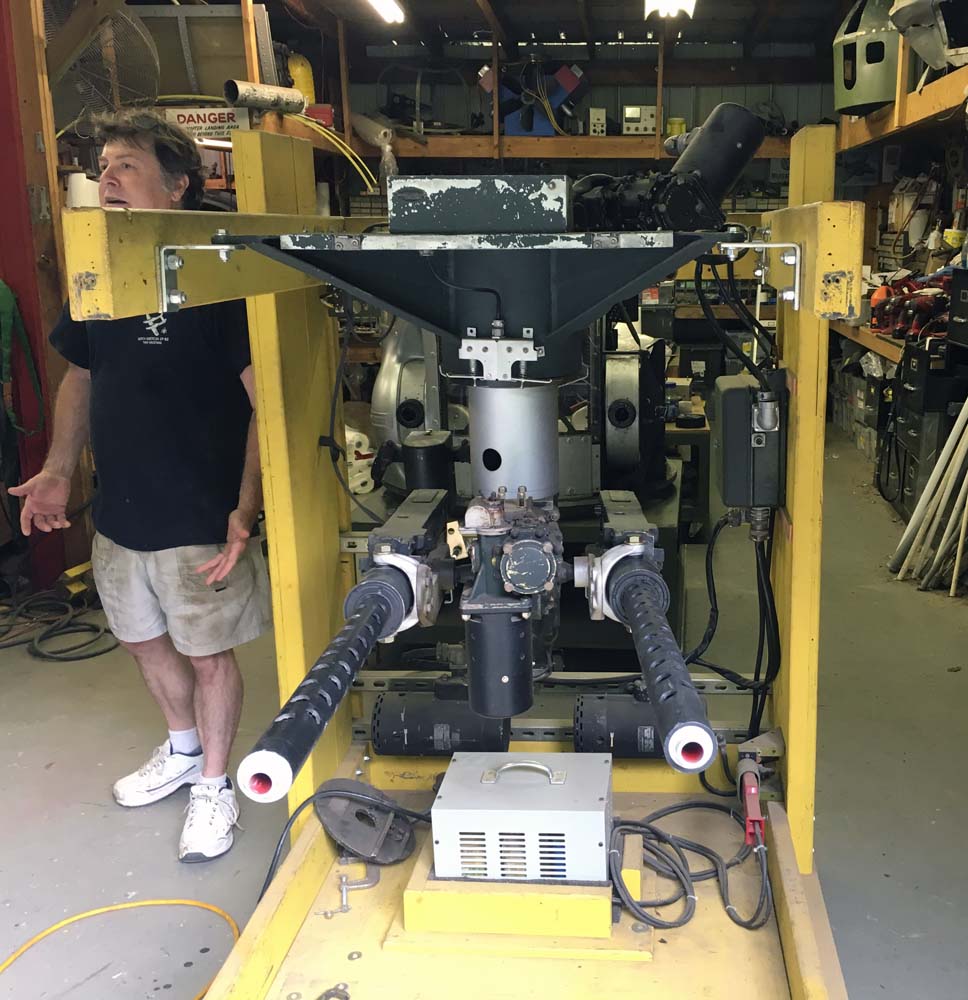
Fred (who is chatting with my wife Megan) stands next to his restored Bendix A-16 Chin Turret. The Bendix A-16 was designed using the A-5 model from the North American B-25 as a base, adapting the turret so as to provide the Boeing B-17 with forward-facing armament. Rather than sitting inside the turret, the A-16 is remotely driven, the gunner (usually the aircraft’s bombardier), sitting inside the airplane above. The machine guns are replica Browning AN-M2 .50 calibers. An aluminum shell normally contains the turret mechanism but it has been removed here to show the turret’s inner workings. One of Fred’s chin turret shells can be seen on the shelf in the back right, painted a zinc chromate color.
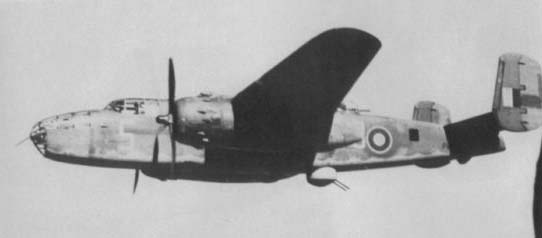
A North American B-25C serving with the Royal Air Force. This is a rare photo as few early B-25s retained their Bendix A-5 Belly Turrets for long. The gunner sat on his knees, looking down through a periscope which was sighted between the guns. This arrangement tended to give the gunners vertigo and, because of this problem, remote belly turrets like the A-5 were hastily removed from service. In 2005, a B-25C (41-12634, 309BG) was pulled from Lake Murray, South Carolina ostensibly to retrieve its belly turret (the bomber had crashed in a training accident on 4 April 1943). The turret was placed on display alongside a small portion of the airframe at the Southern Museum of Flight in Birmingham, Alabama. Fred actually has several Bendix A-5 Belly Turret pieces and hopes to one day rebuild one.

On 6 September 1942, USAAF planners presented to Pres. Franklin D. Roosevelt (D-N) the Army’s needs regarding an air war against the Axis powers. The plan, AWPD-42, said that escort fighters were desperately needed and called for all possible research to be made in that direction. In the meantime, AWPD-42 suggested converting a few long-range bombers into escort gunships, adding extra armor and weapons and having the gunships accompany bombers on airstrikes. This experimental gunship, the YB-40 (in reality, a converted B-17), flew its first mission on 29 May 1943 and was retired on 16 August after the successful introduction of pressurized fighter droptanks. There was one interesting side-effect of the program: the failed Bendix A-5 Belly Turret had been fitted under the gunship’s nose, finally providing the B-17 with an effective forward-facing armament.

The guns of a Boeing B-17G’s ‘chin turret’ are pointed upward to indicate that they are armed and loaded. The success of the YB-40’s chin turret readily apparent, the A-5 was streamlined into the A-16 and made a permanent fixture of the B-17 series. Rather than a clumsy field-modification involving braced guns in the Plexiglas nose, the chin turret was unobtrusive, fast, and effective. As such, the chin turret definitively solved the problem of forward-facing armament on the B-17. The B-17G – easily distinguished by its chin turret – was first flown on 16 August 1943 and became the mainstay of the 8AF for the remainder of the war. Fittingly, 16 August 1943 was also the date of the YB-40’s final combat mission.

The bombardier of the B-17G usually served as the chin turret’s operator. His seat was mounted above the turret with a piece of Plexiglas in the floor, allowing him to keep an eye on the turret’s interior (to watch for any problems). The controls were mounted on a stick and could be swiveled aside when not in use. The sight for the turret was mounted on the roof above. The ammunition was carried inside the turret and the shells were ejected outside when fired.
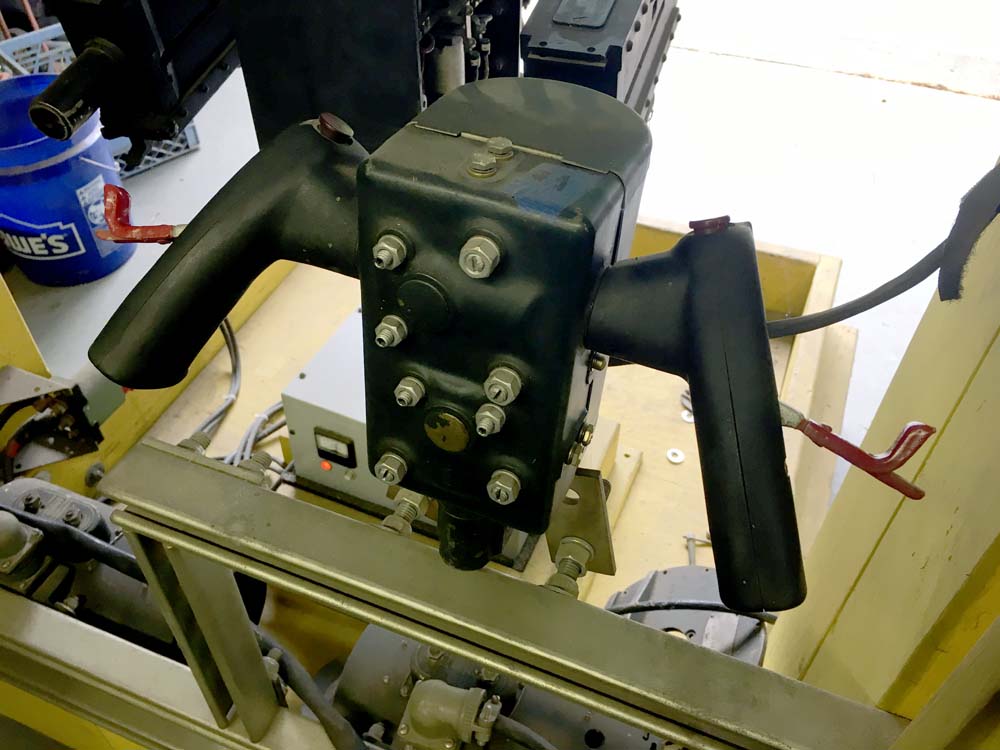
The control yoke for the Bendix A-16 Chin Turret. A pair of red latches on the sides serve as safety switches and must be held tight to activate the turret. The red knobs on top are to increase speed in an emergency and the triggers to fire the guns are on the opposite side. Visible in the background, between the guns, is the junction box, with one side open to reveal the internal gears. It is quite remarkable to watch the interrupter gears inside the box kick-in, preventing the turret from swinging its guns into the airplane.

The back of Fred’s display on the Bendix A-16 Chin Turret. The silver box under the guns is a modern convenience to simulate power normally provided by the B-17. Voltages were by no means standardized aboard US military equipment with radios, for example, needing dynamotors to convert the airplane’s power to the correct levels. Turrets were no different. The two black cylinders closest to the camera are Amplidyne motors – a General Electric trademark for ‘amplify power’ that was used extensively on American turrets. Each Amplidyne motor powers one of the two turret drives: one for elevation (mounted between the guns) and one for rotation (mounted on top of the turret).
We at Hangar Thirteen encourage everyone to support us as we restore and rebuild Lucky Thirteen and her various components. If you have any piece that you think might be of use in this endeavor, please let us know. You might be surprised at how useful your donations might be. While it may be true that locating a unclaimed B-17 top or ball turret is akin to finding a genie in a bottle, we must remain optimistic. We have the willpower and we have the knowledge – we depend on our supporters to help with the rest.
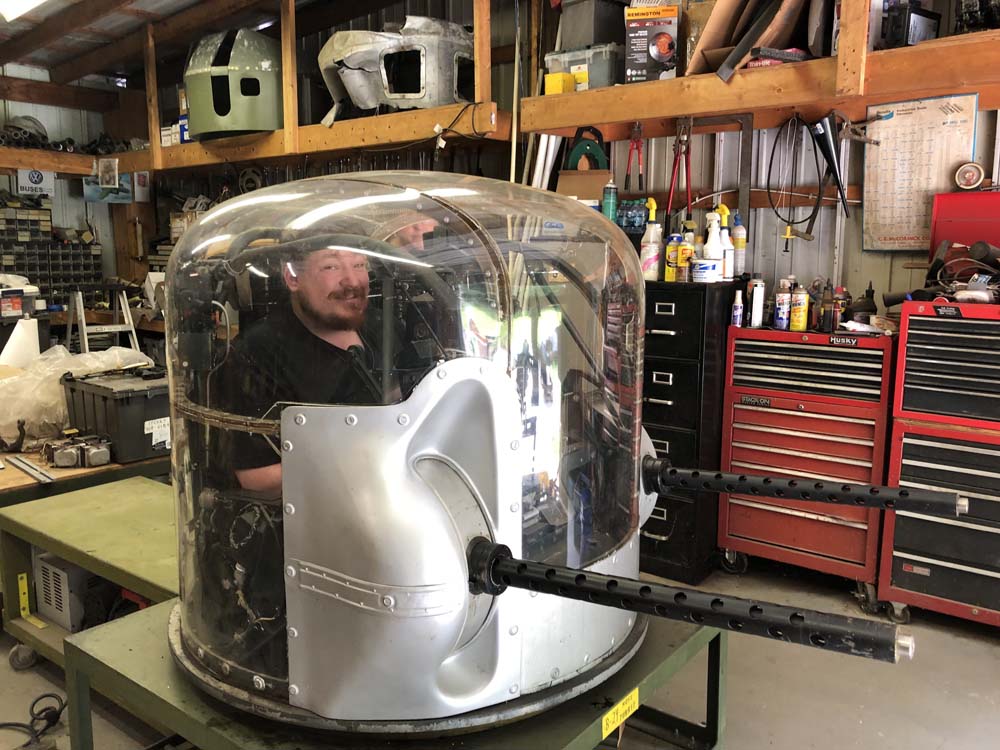
Yours truly at the controls of Fred’s operational Emerson A-15 Nose Turret.
